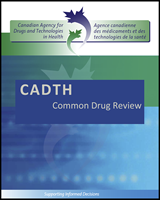Except where otherwise noted, this work is distributed under the terms of a Creative Commons Attribution-NonCommercial-NoDerivatives 4.0 International licence (CC BY-NC-ND), a copy of which is available at http://creativecommons.org/licenses/by-nc-nd/4.0/
NCBI Bookshelf. A service of the National Library of Medicine, National Institutes of Health.
Glycerol Phenylbutyrate (Ravicti) [Internet]. Ottawa (ON): Canadian Agency for Drugs and Technologies in Health; 2017 Apr.
One phase III, DB, crossover RCT conducted in the US and Canada that evaluated the noninferiority of GPB to NaPBA in adult patients with UCDs was included in this review. Study HPN-100-006 enrolled patients with a diagnosis of CPS1, OTC, or ASS deficiencies who had been on dietary protein restriction and/or amino acid supplementation. The patients were required to be on a stable dose of NaPBA for at least one week before study entry. A total of 46 patients were randomized (44 evaluable) to receive two weeks NaPBA followed by two weeks GPB, or two weeks GPB followed by two weeks NaPBA. Results from this study suggested that GPB was noninferior to NaPBA in ammonia control, measured with AUC0–24 for blood ammonia levels at study end points, according to the predefined noninferiority margin of 1.25. GPB also showed similar effects on maximum blood ammonia values and on the percentage of ammonia samples above the ULN when compared with NaPBA. However, interpretation of results is limited, as no minimal clinically important difference is available to evaluate changes in ammonia levels. There were no HACs during the GPB treatment, whereas one HAC occurred during the NaPBA treatment, which led to treatment discontinuation. Cognitive development and HRQoL were not assessed in this study. Patients in the GPB group reported higher risks of AEs compared with those in the NaPBA. These events were generally mild. GPB treatment was associated with more symptoms of lower GI tract disorders, whereas NaPBA treatment was associated with more symptoms of upper GI tract disorders. One case of hyperammonemia that led to treatment discontinuation was observed in the NaPBA group. After being treated with GPB, patients reported fewer UCD treatment-specific symptoms such as bad taste and body odour.
Findings from three longer-term, open-label, non-comparative studies suggested that, after one year of treatment with GPB, the effects of GPB on blood ammonia and glutamine levels appeared to be maintained in both children and adults. The number of hyperammonemic episodes per patient was reduced compared with the values 12 months before screening. Almost all patients experienced AEs after one year of treatment with GPB. The interpretation of results from these long-term studies is challenging because of several important limitations such as the study design, sample size, and the study duration.
- CONCLUSIONS - Glycerol Phenylbutyrate (Ravicti)CONCLUSIONS - Glycerol Phenylbutyrate (Ravicti)
- Homo sapiens thioredoxin related transmembrane protein 2 (TMX2), transcript vari...Homo sapiens thioredoxin related transmembrane protein 2 (TMX2), transcript variant 6, mRNAgi|1890359023|ref|NM_001347891.2|Nucleotide
- Rattus norvegicus fucosyltransferase 4 (Fut4), mRNARattus norvegicus fucosyltransferase 4 (Fut4), mRNAgi|309243083|ref|NM_022219.3|Nucleotide
- Rattus norvegicus vomeronasal 2 receptor, 18 (Vom2r18), mRNARattus norvegicus vomeronasal 2 receptor, 18 (Vom2r18), mRNAgi|1937866099|ref|NM_173318.2|Nucleotide
- Clinical Review Report - Glycerol Phenylbutyrate (Ravicti)Clinical Review Report - Glycerol Phenylbutyrate (Ravicti)
Your browsing activity is empty.
Activity recording is turned off.
See more...
